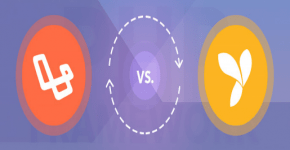9 Best Effective Ways to Improve Website Speed
A website’s speed significantly impacts user experience, Search Engine Optimization, and conversion rates. Therefore, the website must load fast. To enhance the loading speed of a website, we should know the factors that impact the website’s speed and make those factors work flawlessly and efficiently to improve website speed.

9 Most Effective Ways to Improve Website Speed
Here, we will get to know about 9 such ways that will increase site loading speed drastically.
1. Choose the right hosting solution
In today’s world, every business claims its services to be the best. Similarly, every web hosting provider will say their hosting is the best and fastest. So, it’s our job to compare different web hosting providers based on their reviews and choose the most efficient one to improve website loading time.
Although we can change the web hosting service anytime we want, that would be a bit complicated. To avoid those hassles, we should choose the best hosting service to improve website speed from the very beginning.
2. Check Site Performance
Testing the speed of the website tells us how the website is performing. Regular Testing of a website keeps the developer aware of the overall performance of the website, its flaws, etc. It helps to identify which areas are causing a slowdown and impacting the website loading time so that we can work on that particular area and fix the issue rather than checking the whole website. There are many free and paid high-quality websites to test the speed of a website. Google also has a tool for testing the Site speed. We should test the performance of the website to increase site loading speed.
3. Compress and Optimize Images
Images make our website’s content more catchy and easily understandable, but large-sized images can impact the website’s loading time.
Therefore, to improve site loading time, we should compress and optimize our large-sized images in such a way that even the quality of the image is maintained and it also doesn’t put a burden on the website. In simple terms, compressing is nothing but reducing the image size by reducing the pixels. Many free tools are available online for compressing and optimizing the images and even changing their formats if required.
4. Reduce HTML, CSS, and JavaScript
Simplifying the codes of HTML, CSS, and JS also improves website speed. This means keeping our code clean and short, removing extra spaces, comments, etc., to reduce the size of the file. Smaller files are also easier to combine, resulting in a more efficient website with less loading time. Tools are also available to minimize the code by cutting off unnecessary elements from the HTML, CSS, and JS Code.
5. Keep CSS before JavaScript
We should keep the CSS at the header and JavaScript at the footer of the HTML Document. It is called Deferring JavaScript Loading. When we go to a website, the browser loads all the scripts before it carries out the rest of the pages. We know that the CSS is responsible just for the styling of our website. The website will still work fine if we remove the CSS, just it won’t look good. And JavaScript is responsible for the website’s connectivity, so it will still work fine if we place it at the footer. It will start working once the page has been loaded.
To improve site loading time, CSS should be kept at the header and JS at the footer. The website will work the same way, but it doesn’t have to wait to load all the JavaScript before displaying the content on the screen, leading to enhanced loading time.
6. Minify the number of HTTP Requests
Many web pages require the browser to make multiple HTTP requests for different resources on the page, be it scripts, CSS files, or images. Even many web pages will need a large number of HTTP requests. This surge in requests puts a load on the website and impacts the website loading time opined a website development company.
Due to these inconveniences, we should minimize the requests for various resources on web pages, such as scripts, images, etc. With the help of a speed test, we should figure out which HTTP request is consuming more time and then find a better solution for that delay. If the image is causing slow page loading, we should look for better image hosting services, such as a content delivery network (CDN).
7. Enable Caching of Browser
Caching of Browser is another way to improve site loading speed. Caching enables the browser to store various information, such as images, CSS, and JS files. Hence it does not have to load the entire webpage each time a user opens the page.
Some plugins are also available online for browser caching to improve website speed. Some good plugins available are W3 Total Cache, WP Rocket, etc.
8. Remove unnecessary Plugins
Not all plugins are the same. Using too many plugins on our website burdens it and makes it slow. Additionally, using out-of-date plugins compromises the integrity and security of the website, causing performance problems.
Selecting and removing plugins that aren’t being used right now is a simple way to decide which to draw. We can also determine which plugin is slowing the website using speed testing tools. We need to run a speed test while keeping one plugin active and disabling all other plugins. We have to apply this to all other plugins one by one. This will help to identify which plugin is causing the slowdown. This helps to enhance the website loading time.
9. Reduce Server Response Time
The length of the DNS Lookup is a crucial component of website loading time. It is a server that maintains an IP address database. DNS transforms a URL entered into a browser into an IP Address to identify its location online.
Our Internet Service Provider performs a DNS Lookup to find the IP Address of the entered URL. The time taken for DNS Lookup depends on the speed of your DNS provider. You should probably switch to a faster DNS if it takes longer. If you utilize a slow DNS, your website will take longer to load. Utilize a quicker Domain Name System to reduce the time it takes for your website to load.
Conclusion
These are some of the measures we can take to improve website speed. But there could be many more factors affecting your website’s speed. It could be anything from HTTP requests to server response time to a number of large images to redirects you have on your website.
Also, we need to determine first what website’s loading speed is optimal and then go for fixing the rate. Because the load time may be already optimal, you are viewing it slows and juggling unnecessarily for an issue that doesn’t exist. So, first, test the website’s performance, and then if it is found to be slow, we should take the necessary measures mentioned above to enhance the website’s loading speed.





